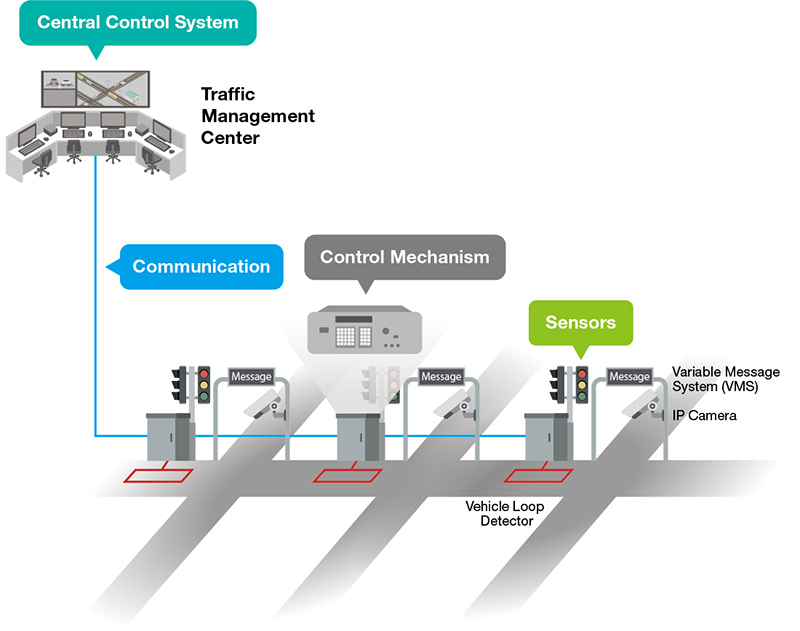With the persistent rise in traffic congestion impacting infrastructure, the environment, and commute times, urban administrators and traffic experts are looking to intelligent transportation systems (ITS) to find practical and cost-efficient solutions to enhance road safety and traffic control. These systems harness state-of-the-art analytics enabled by the vast volumes of top-notch data gathered by diverse sensors.
At the heart of an ITS, the Advanced Traffic Management System (ATMS) integrates sensors equipped with communication and control technologies to monitor traffic conditions and relay pertinent data to the central traffic command center through a citywide network. The command center then merges information from various sources to formulate, assess, and execute traffic control strategies, while also disseminating relevant data to all road users for route planning and safety purposes.
Enhancing Components of an ATMS
An ATMS brings together traffic monitoring, analysis, and control within a unified platform via a network. The greater the influx of real-time traffic data into the central control system, the more robust its capabilities become. Hence, a dependable network is crucial in enabling operators to make informed traffic management decisions.
An ATMS comprises the following essential components:
Control Mechanism: At each intersection, the control mechanism scrutinizes traffic data from various sensors to determine the optimal timing for each traffic signal. This is facilitated by multiple subsystems and devices such as traffic lights, variable message systems (VMS), data from road weather information systems (RWIS), and CCTV systems.
Sensors: Data from sensors plays a critical role in recognizing traffic patterns and devising traffic control strategies. Common sensors in an ATMS include loop detectors, laser or radar sensors for motion detection, and cameras widely used in these applications.
Communication: Communication between control mechanisms at intersections and the central control system is essential for wired or wireless network interoperability, allowing for effective coordination of signal switching at multiple intersections.
Central Control Systems: The Central Control System (CCS) serves as the nucleus of the ATMS, overseeing the entire traffic management operation inherently.

Due to the rising prevalence of cloud-based traffic management platforms and the extensive use of smart sensors, modern ATMSs are more effective and resilient. Nonetheless, these advanced sensors and systems also raise several connectivity concerns. Before modernizing your current traffic management systems, consider addressing the following three inquiries.
First, is my connectivity solution facilitating seamless integration of various sensors into the network?
An ATMS depends on diverse sensor data to provide insights for both traffic management input mechanisms and information output devices used for communicating messages to road users. The interfaces necessary may involve serial-based or digital/analog data points; therefore, your connectivity solution should provide multiple yet adaptable communication interfaces within a compact hardware design for efficient installation and maintenance. Hence, opt for a compact and dependable solution for connecting diverse sensors for seamless and robust integration.
Second, does my connectivity solution offer ample cybersecurity measures for critical infrastructure protection?
Transportation systems represent critical infrastructure crucial for national security and safety. Networked and cloud-based services can be vulnerable to malicious cyber threats. Implementing proper device configurations with updated firmware installations and security patches aids in safeguarding both data and communication within the network. Therefore, select a solution designed with security in mind and equipped with essential security features to enhance your device security.
Third, how can I effectively manage numerous field devices distributed across varied networks and sites?
The growing deployment of smart sensors across diverse field sites necessitates an increased number of networking devices for data collection and communication. This expansion can lead to complexity and potential network overload within traffic system networks. Configuring, maintaining, and troubleshooting these devices and networks can be laborious and time-consuming. Hence, a well-designed solution from the outset is essential. For instance, an efficient network management tool visualizing the statuses of your networking devices and offering a user-friendly interface for mass configurations can prove invaluable.
As a provider of industrial connectivity and networking solutions, Moxa has assisted numerous clients in establishing reliable networks for ATMS in intelligent transportation systems. Access our case studies to learn how we’ve supported other organizations in enabling future-proof communication for their ATMS.
Searching for suitable connectivity or networking products for your project? Download our E-book to discover the key criteria to consider when selecting the most fitting solution for your requirements.
- Not Only for Automobiles: Discovering CANbus Technology in Various Industrial Settings - October 29, 2024
- Boost Your Network Performance: An Exciting Manual to PoE Switches! - September 10, 2024
- Understanding Gigabit Switches: Industrial vs Regular Gigabit - September 4, 2024


